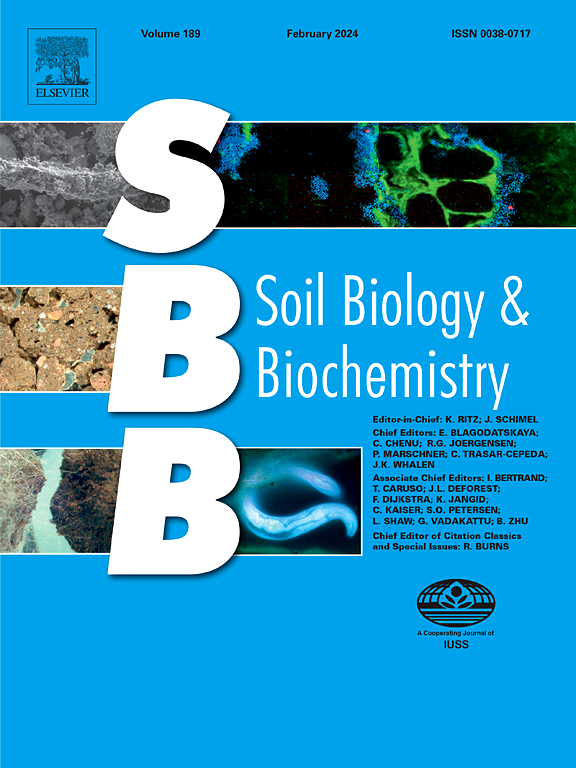Functional molecular diversity of dissolved organic matter explained by predicted genome size of soil microbial communities
IF 10.3
1区 农林科学
Q1 SOIL SCIENCE
引用次数: 0
Abstract
Microbial decomposition of plant litter has been shown to decrease the molecular diversity of dissolved organic matter (DOM), but it remains unclear whether these DOM formation processes are conserved across ecosystems with differing microbial communities. To fill this knowledge gap, we investigated plant litter decomposition and DOM formation over a period of 150 days using materials sourced from five different ecosystem types. We tested whether microbial diversity alters DOM molecular diversity by manipulating the microbial community structure through serial dilution to produce “high” (10°) and “low” (10−10) diversity communities from each ecosystem. We measured microbial richness, microbial diversity and predicted genome size using 16S rRNA gene sequencing and DOM molecular diversity using tandem liquid-chromatography mass spectrometry (LC-MS/MS). We found that the functional molecular diversity of DOM across ecosystems was correlated with the average predicted genome size, a proxy for the metabolic potential of microbial communities (Pearson's r = 0.61, p = 0.008). Ecosystem type explained the most variation in DOM composition (ADONIS PERMANOVA; R2 = 0.89, p-value = 0.001), but specific microbial phyla (e.g., Firmicutes, Bacteroidota, Chloroflexi) and genera (e.g., Sphingomonas, Stenotrophomonas, Leifsonia) were also correlated with DOM composition across the five ecosystems. Although DOM molecular richness was most strongly correlated with ecosystem type (F(4,19) = 6.21; p-value = 0.002), DOM functional molecular diversity had a stronger relationship with the predicted genome size of the microbial community (F(4,19) = 21.18; p-value = 0.0002). The positive relationship between DOM functional molecular diversity and microbial community genome size suggests that a larger microbial metabolic capacity produces a greater diversity of functionally dissimilar DOM compounds.
土壤微生物群落基因组大小预测解释溶解有机质功能分子多样性
植物凋落物的微生物分解已被证明会降低溶解有机质(DOM)的分子多样性,但这些DOM的形成过程是否在不同微生物群落的生态系统中是保守的尚不清楚。为了填补这一知识空白,我们使用来自五种不同生态系统类型的材料,研究了150天内植物凋落物的分解和DOM的形成。我们测试了微生物多样性是否会改变DOM分子多样性,方法是通过连续稀释来操纵微生物群落结构,从每个生态系统中产生“高”(100)和“低”(10-10)的多样性群落。我们使用16S rRNA基因测序和串联液相色谱质谱(LC-MS/MS) DOM分子多样性来测量微生物丰富度、微生物多样性和预测基因组大小。我们发现,跨生态系统DOM的功能分子多样性与平均预测基因组大小相关,这是微生物群落代谢潜力的代理(Pearson’s r = 0.61, p = 0.008)。生态系统类型解释了DOM组成的最大变化(ADONIS PERMANOVA);R2 = 0.89, p值= 0.001),但特定的微生物门(如厚壁菌门、拟杆菌门、氯氟菌门)和属(如鞘单胞菌、窄养单胞菌、Leifsonia)也与5个生态系统的DOM组成相关。DOM分子丰富度与生态系统类型相关性最强(F(4,19) = 6.21;p值= 0.002),DOM功能分子多样性与微生物群落预测基因组大小的关系更强(F(4,19) = 21.18;p值= 0.0002)。DOM功能分子多样性与微生物群落基因组大小呈正相关,表明微生物代谢能力越大,功能异DOM化合物的多样性越大。
本文章由计算机程序翻译,如有差异,请以英文原文为准。
求助全文
约1分钟内获得全文
求助全文
来源期刊

Soil Biology & Biochemistry
农林科学-土壤科学
CiteScore
16.90
自引率
9.30%
发文量
312
审稿时长
49 days
期刊介绍:
Soil Biology & Biochemistry publishes original research articles of international significance focusing on biological processes in soil and their applications to soil and environmental quality. Major topics include the ecology and biochemical processes of soil organisms, their effects on the environment, and interactions with plants. The journal also welcomes state-of-the-art reviews and discussions on contemporary research in soil biology and biochemistry.
 求助内容:
求助内容: 应助结果提醒方式:
应助结果提醒方式:


